Do you feel like promoting your content doesn’t seem to bring in the results you’re looking for?
Sharing your latest blog post on LinkedIn or Facebook sounds great. Sure, you might even ramp things up by resharing old (but valuable) content, so that a bigger part of your target audience sees it.
That works. But only for a while. A few days (or weeks) after that?
Crickets.
4.4 million posts go live every day and 87% of B2B marketers use the same social media channels you’re using to promote their content.
The solution? Content advertising.
In this post, you will learn what content advertising is and how you can use it to boost your inbound marketing efforts and get the results you’re looking for.
Ready? Let’s get rolling.
Scale insightful marketing content across the web.
We help you grow through expertise, strategy, and the best content on the web.
What is Content Advertising?
Content advertising involves creating high quality content and then using different paid distribution channels to promote it.
Sounds simple right? But it isn’t.
You have come across paid ads on Facebook, Twitter, or LinkedIn directing you to a blog post, an ebook, or even a webinar.
Nothing seems out of the ordinary because you’ve also seen ads promoting a particular product or service. So you might be wondering…
Why does content advertising matter?
Your target audience expects to read relevant, engaging, and useful content. Anything less than that and they will click away.
As you spend months publishing great content around a keyword you want to rank for, your competitors are equally doing the same, meaning that it’s harder to stand out.
Besides, you’re probably competing with brands that have dominated the SERPs which reduces your chances of ranking for competitive keywords.
So you don’t want to hope that one day you will outrank them. Well, you might, but it’s going to be a while before you get there. And you need traffic, leads and sales, ASAP.
Another way around this would be publishing organic content then using paid distribution to reach your target audience a.k.a content advertising.
And here’s the interesting part…
Advertisers are prioritizing audience targeting and ad placement to make it easier for their target audience to find and read the content they publish.
That explains why 33% of them are using paid advertising as part of their content marketing strategy to improve brand awareness. And by 2022, companies are going to spend more than $280 billion on advertising.
So If you can’t beat ‘em, join them.
Still not convinced?
Here are two more reasons why you should be using content advertising:
- Get more touch points with potential customers: A buyer’s journey isn’t linear. They use different channels to find what they need. Content advertising allows you to show up on these channels e.g., social media and in online forums, where you interact with them to build familiarity and trust before asking them to buy your product.
- Reduce the cost of customer acquisition: Promoting branded content to a targeted audience helps you acquire more leads at scale so you can focus on nurturing them till they’re ready to buy from you.
Here’s another way to think about it…
Your potential customers need information that provides answers to their questions and shows them how to solve their problems.
The question is, do you offer engaging content that answers their questions and provides relevant solutions?
If you do, then you need to promote it through different distribution channels.
Examples of Content Advertising in Action
Before you spend money promoting content, it’s important to study what other brands have been doing.
You’ll learn elements that make their ads effective so you know what you need to include in your ads to help you hit your business objectives.
In other words, steal like a great artist.
Here are three examples of ads promoting content and why they’re effective:
Example #1: SEMrush
Relevance in your Facebook ads will determine how well they perform and, consequently, your return on investment.
That means knowing the questions your audience is asking needs to be top of your list of priorities.
Take a look at this ad from SEMrush illustrating this concept:
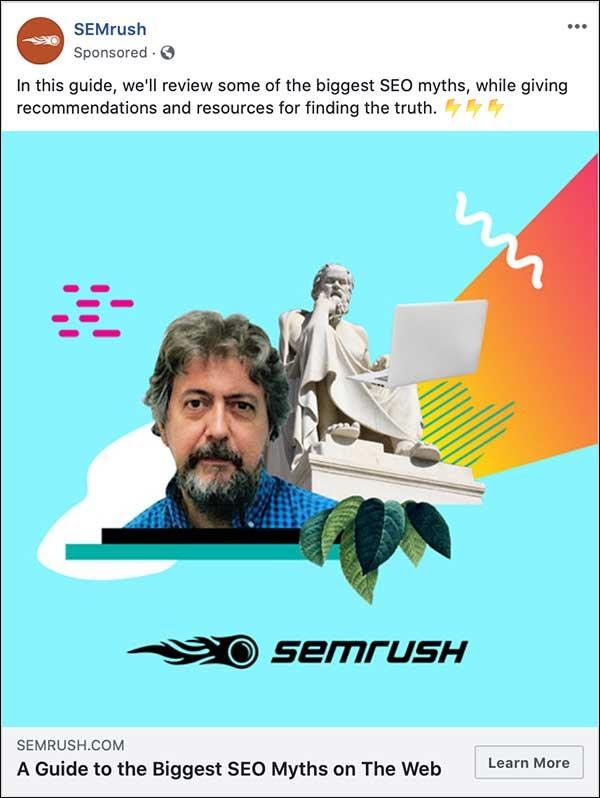
SEO is evolving. Given the constant updates from Google and the amount of information out there on “SEO best practices”, someone needs to come up and call out BS for what it is — BS.
And that’s exactly what SEMrush has done here — busting myths then pointing SEO professionals in the right direction. The image also does a great job here, putting Bill next to Plato, a subtle suggestion that you’re about to hear some ancient truths (ahem) so you better pay attention.
Well played, Bill.
Key content advertising takeaway:
You don’t need a ton of content to promote on Facebook, just make sure content that provides answers to burning questions that your audience is asking.
Example #2: Drift
Negative messaging in copywriting influences our emotions by prompting us to take action or else, something bad is going to happen. And in Drift’s LinkedIn ad, they’re leveraging this by making a bold claim (B2B marketing is broken), and then goes on to explain why then provides a way to fix it:
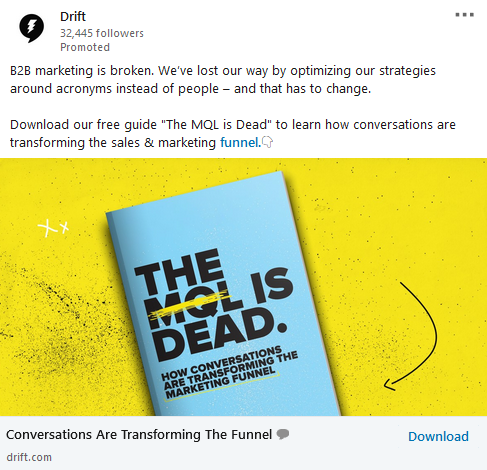
Key content advertising takeaway:
Does your content reflect what you stand for? Are people blindly following a “best practice” that’s leading them astray? Create a post that calls them out on the same and use negative messaging to make them pay attention and take action.
Example #3. Skillshare
In one of their Twitter ads, Skillshare piggybacks on Rand Fishfikn’s brand and influence to reach a new audience while adding credibility to their free class.
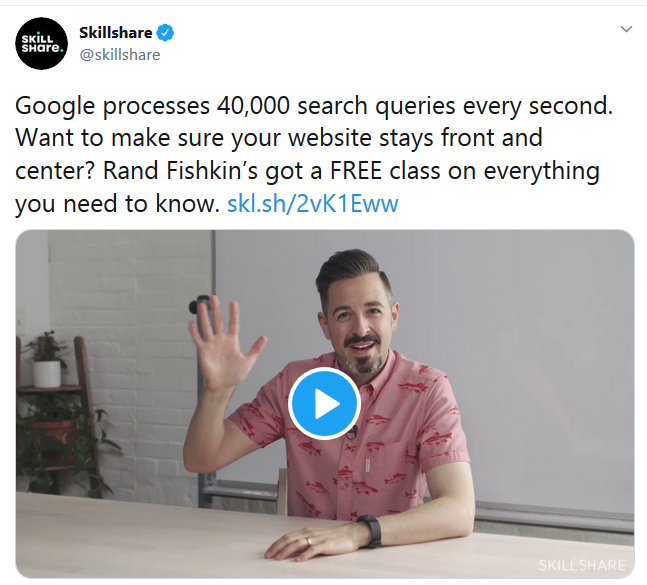
Key content advertising takeaway:
If an industry influencer contributed to your content then by all means, find a way to include them in your ads. While a video ad would be ideal, their image or quote that appears in your ad will still earn you credibility.
How to Get Started With Content Advertising
Having seen how content advertising looks like on social media, you have an idea of what content you can promote and what to do to stand out. This section will give you a step-by-step walkthrough showing you how you can get started with content advertising.
Step #1: Identify Your Goals
Do you want to improve brand awareness? Generate leads? Improve conversions?
Having objectives helps you know the type of content to promote and the type of results to expect.
For instance, if you’re promoting content to build brand awareness, there’s a high chance that your audience has never heard of you before. Here are the results you should expect:
- An increase in new website visitors from social media
- More branded searches as a result of established thought leadership
- Emergence of segments in your target audience based on their interests
If you’re using content advertising for lead generation, your target audience knows about you and what you offer. Here are some of the results you should expect:
- More email subscribers
- An increase in the number of direct visitors who visit your blog
- A bigger retargeting list for potential customers
If you’re using content to improve conversions, you’ve interacted with your target audience severally, and they’ve probably expressed interest in your product. Here are some of the results you should expect:
- More trial signups
- New customers
To choose the right objective, look at your buyer’s journey to know where and when your prospects need content to proceed with their journey.
You’ll also know the type of content they need. For example, a prospect in the awareness stage needs content that provides information without coming across as technical which might leave them feeling intimidated.
Step #2: Study Your Competitors
Knowing what your competitors are doing to promote their content and get more traffic helps you identify gaps in their content distribution strategy that you can fill in.
For example, if they’re only relying on Facebook ads to promote their content, then you should consider showing up where they’re absent e.g LinkedIn, Twitter, or native advertising.
Content quality matters so you also want to evaluate the quality of content they are promoting. Does their content demonstrate expertise, authority, and build trust? If not, then that’s another gap to fill in by improving your content so that your ads perform better.
Step #3: Start Small
Not all content deserves paid promotion. Not even your latest blog post. You want to make sure you’re promoting high-quality posts to get a good ROI.
Besides you want to have a couple of wins with content advertising before going all in, right?
If you’ve been publishing consistently, then you probably have a few posts that are off the charts. Start with these as you learn what works and what doesn’t.
These pieces performed well organically so a paid promotion campaign would put them on steroids. In addition, updating an old but valuable content blog post costs less than publishing a new blog post from scratch.
We’ve done before that and ended up reducing our ad spend while improving our relevance score. Take a look:
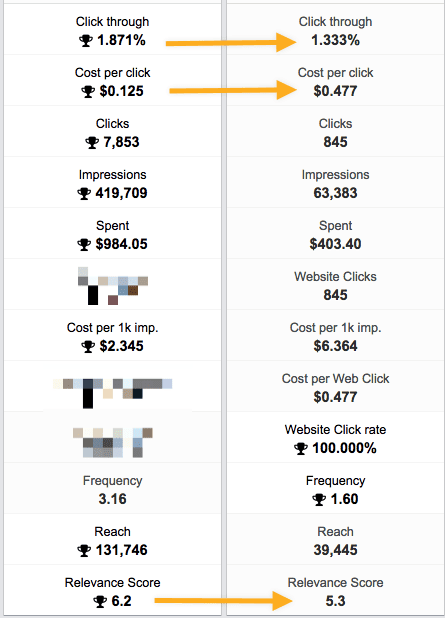
Read the full case study here.
Step #4: Have an Ascension Plan
There’s no point of advertising your content without an ascension plan.
An ascension plan is the next step that a reader has to take once they’re done reading your content. It doesn’t matter whether you’re using content advertising for brand awareness, lead generation, or retargeting to convert your leads into customers.
An ascension plan could be as simple as internal linking to get the reader to visit more pages with content on your site. It could also be a popup with a relevant lead magnet, or a link to a landing page to sign up for a trial.
Here’s an example of an ascension plan in this blog post on creating a content strategy framework:
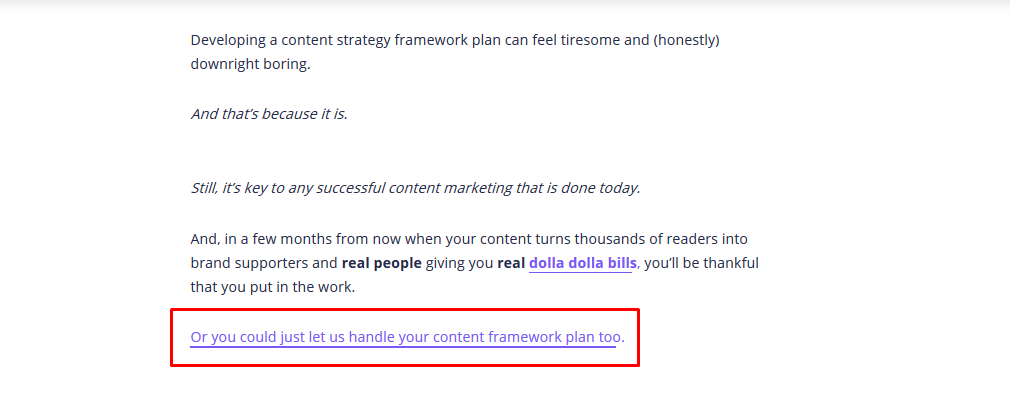
It’s subtle and, given that you won’t feel like you’re being asked to head to a sales page, you won’t help but click on the link even if you’re just curious.
Here’s another example from Wordable. If you’ve endured hours of copying and pasting content on WordPress before publishing, then anyone telling you they saved time doing the same is worth listening to.
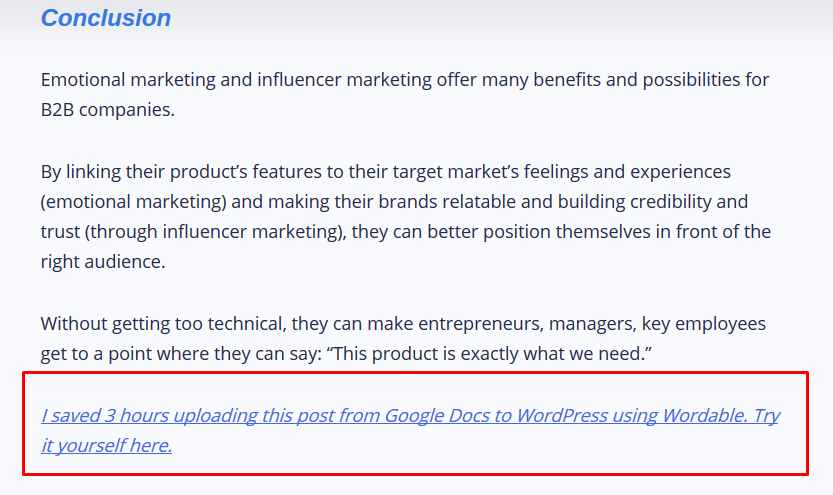
The ascension plan here presents a natural progression of events in the buyer’s journey of a Wordable prospect, and it just makes sense to click and see how the tool works.
Step #5 Optimize Your Ads
Running content ads is one thing. However, optimizing those ads is a completely different thing altogether.
Once your campaign has started, you need to start tracking it continuously to see how it’s performing.
This will help you get an idea of whether it’s succeeding or failing as per your expectations.
Based on the analysis of its performance, you can start to modify your content ads and optimize them for better results.
However, to succeed at it, it’s essential to have good knowledge about analytics. Without it, you wouldn’t be able to analyze your campaign performance well.
Conclusion
Hopefully this article has given you a better understanding of what content advertising is, why it matters and how to get started.
The most important thing to remember is that your content is still an asset and you need to come up with ways to get more ROI on the investment you make when creating it.
When getting started, identify your objectives, understand what your competitors are doing, start small, and have an ascension plan in place.
And if you have any questions about content advertising, don’t hesitate to reach out to us to help you know what content you need to create (or update) and promote to get more traffic and conversions.



